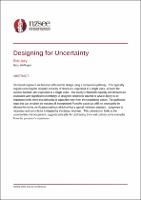| dc.contributor.author | Jury, Rob | |
| dc.date.accessioned | 2021-06-22T04:01:48Z | |
| dc.date.available | 2021-06-22T04:01:48Z | |
| dc.date.issued | 2021-04-14 | |
| dc.identifier.uri | https://repo.nzsee.org.nz/xmlui/handle/nzsee/2334 | |
| dc.description.abstract | Structural engineers are familiar with seismic design using a compliance pathway. This typically requires ensuring the provided capacity of structures, expressed as a single value, exceeds the seismic demand, also expressed as a single value. The reality is that both capacity and demand are associated with significant uncertainty so designers need to be attuned to what is likely to be important in the event that demands or capacities vary from the compliance values. The additional steps that can be taken are not great if incorporated from the outset but will not necessarily be allowed for in the verification methods which reflect a typical minimum standard. Judgement is necessary and can only be instigated by the design engineer. This presentation looks at the uncertainties that are present, suggests principles for addressing them and outlines some examples from the presenter’s experience. | |
| dc.language.iso | en | |
| dc.publisher | New Zealand Society for Earthquake Engineering | |
| dc.relation.ispartofseries | 2021;1002 | |
| dc.subject | Keynote | |
| dc.title | Designing for Uncertainty | |
| dc.type | Article | |

